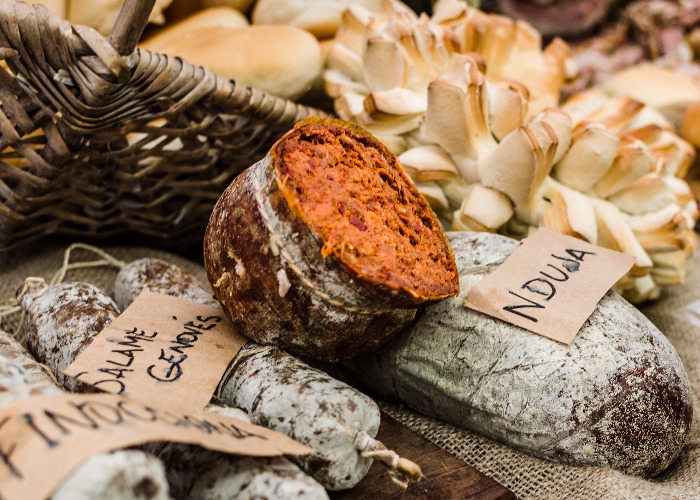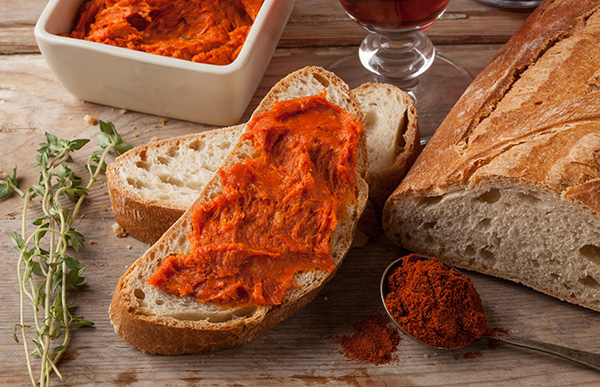
Calabria’s chilli-laden salami certainly packs a punch. Mary Novakovich looks at the hottest thing to come out of Italy.
It’s the true taste of the Italian south – warm, intense and stuffed with chilli. And now ’nduja is becoming easier to find outside of Italy. In the past year you might have spotted it everywhere from pizza toppings and pasta sauces to toasties and antipasti.
What is ’nduja?
This soft spreadable salami from Calabria is one of the hottest foods from a region that’s already known for its chilli addiction. ’Nduja (pronounced in-DOO-ya) is made up of several parts of a pig, including what some might regard as the least appetising (lung, head, intestines). The generous addition of pig fat is what makes it so spreadable.
What gives it its distinctive colour is the copious quantity of vivid red Calabrian chilli peppers – peperoncini calabrese – that are added, along with spices. Stuffed into a pig’s gut and tied up with string, the salami is then aged for about two years. There’s a milder and more processed version that comes in jars.

Hans Geel/Shutterstock
As Calabria has historically been one of Italy’s poorest regions, its cuisine has had to make the most of cheap cuts of meat. While some producers are using less offal, pork fat is still one of the most important ingredients. As is chilli, the so-called droga dei poveri – the drug of the poor.
These long red chillies go into a lot of Calabrian cookery, even ice cream. The heat these chillies generate in ’nduja has much more depth and intensity than you would expect, rather than blowing your head off.
Where did ’nduja come from?
’Nduja’s centre of production is the unprepossessing village of Spilinga in Calabria’s Vibo Valentia province, equidistant from the beaches at Capo Vaticano and the pretty coastal town of Tropea.
The Italian food academy Academia Barilla believes ’nduja came from the French tripe sausage andouille, which soldiers would have brought when they were in Calabria fighting the Spanish during one of the region’s many turbulent periods. Thanks to the abundance of chillies in the region, the rather unappetising French sausage has been given a pungent and palatable Calabrian kick.
The region is full of small-scale producers whose pigs forage freely in the forests, eating chestnuts and herbs. If you find yourself in this part of Calabria in early August, join the celebrations that take place every year in Spilinga. Villagers pay homage to ’nduja in a day-long festival with music, dancing and huge amounts of food.
Hans Geel/Shutterstock
Where can you find ’nduja?
The version that comes in jars is becoming easier to find in food shops and some supermarkets, as well as online. Fresh ’nduja is harder to come by outside of Calabria, although there are online suppliers. Your best bet is to look out for specialist Calabrian or southern Italian stalls in food markets. A whole ’nduja can be pricey and should be eaten within a week. It’s more common – and practical – to find ’nduja in separate vacuum-packed chunks. Marks & Spencer sells ’nduja in jars, as well as a tomato and ’nduja pasta sauce.
How do you cook with ’nduja?
As it’s ready to eat, the simplest thing to do is just spread it on toasted bread as a snack or serve as part of an antipasti plate of meats and cheeses. It’s also the main ingredient in fileja con ’nduja, Calabria’s most popular pasta dish. Fileja is a long thin pasta that’s been wound around a thin skewer or knitting needle, and its shape holds an ’nduja sauce beautifully.
The sauce itself can be made in an infinite number of ways, but you can start by frying some garlic in olive oil before adding the ’nduja and letting it fall apart. Add ripe plum tomatoes and, if you like, some red wine. Let everything reduce while the fileja pasta cooks (which can be up to 18 minutes). Mix the pasta in the sauce and top with grated pecorino if you want to dilute the sauce's heat.
Along with the garlic, you could also add a chopped Tropea onion – la rossa di Tropea – another Calabrian staple that’s much sweeter and longer than standard red onions. But as they’re rarer outside of Calabria than ’nduja, make do with a finely chopped shallot. Some recipes consist of purely ’nduja and tomatoes to keep things simple.
Fileja pasta can be hard to track down too, but the sauce also goes well with bucatini, in spite of the fact that it’s a completely different shape.
neil langan/Shutterstock
What else can you do with ’nduja?
A little goes a long way. Put a few splodges of it on pizza if you want a piquant topping. A spoonful can be added to other pasta sauces as well as soups and casseroles. A judicious amount can work well with seafood linguine dishes. For a spicy breakfast, put a few dabs of ’nduja in scrambled eggs.